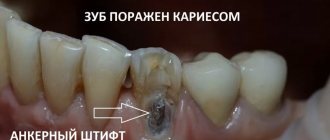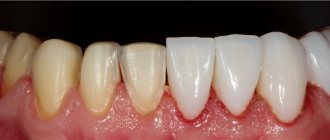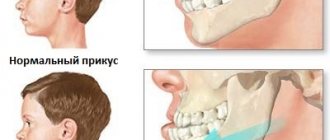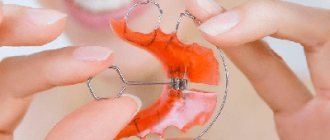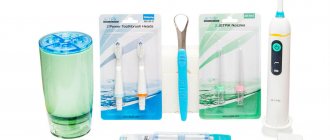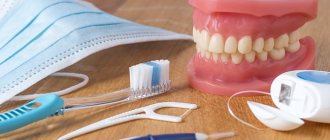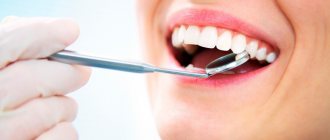Chief editor of the site:
Snitkovsky Arkady Alexandrovich
Chief physician of the professorial dentistry “22 Century”, dentist, orthopedic dentist
Author of the article:
Scientific team of dentistry “22 Century”
Dentists, candidates and doctors of medical sciences, professors
Any effective dental prosthetics begins with a consultation with an orthopedic dentist, during which he determines the volume, type and price of oral cavity preparation . All preliminary procedures and manipulations depend not only on the clinical situation, but also on the type of design chosen.
Dental prosthetics in dentistry “22 Century” Thus, installing metal ceramics or a partial removable denture requires completely different treatment, which can be single-stage or complex and consist of: therapeutic, surgical, orthodontic, orthopedic.
Also, before starting work, the doctor may recommend taking a survey (panoramic) photograph - an orthopantomogram (OPTG). It allows you to assess the condition of teeth and bone tissue, and diagnose hidden problems that may appear after the installation of a prosthesis and require their elimination.
Therapeutic preparation for dental prosthetics
Therapeutic preparation means sanitation of the oral cavity, that is, the elimination of all foci of infection. This includes professional hygiene - removal of soft and hard plaque, in other words - stone; elimination of acute processes of the mucous membrane; treatment of caries and its complications - pulpitis and periodontitis. Also the preparation of supporting teeth includes endodontic treatment and filling of root canals, both primary and re-treatment of previously filled ones in the presence of inflammatory foci at the apexes of the roots. This manipulation is required in the manufacture of dentures with the preparation of a significant amount of enamel and dentin and prevents the development of traumatic pulpitis and pain in the patient.
Most often, depulpation is indicated for metal ceramics, clasp dentures supported by half-crowns, and restoration of severely damaged teeth using inlays or pins.
Crowns
Crowns are placed:
- on pulpless teeth to protect them from destruction;
- to units destroyed by more than 50%
; - on teeth in which only the root is preserved;
- with abnormal abrasion of enamel;
- for aesthetic defects, the correction of which is impossible by other means;
- for implants.
After all the preparatory manipulations, the doctor grinds the tooth down to the thickness of the future crown. If the tooth is completely destroyed, a pin is inserted into the root. Then the tooth stump is prepared. It is given a shape that will allow you to put the crown on top and ensure its stability.
After this, impressions of the teeth are taken, always of both jaws, to ensure good occlusion (touch) of the teeth. Based on the impressions, crowns will be made in the laboratory, which the doctor will adjust so that they fit tightly on the supporting tooth.
During the fitting, the orthopedist checks the correctness of the bite, contact with adjacent teeth, and how comfortable the patient is with the crown. For the first few days, it is recommended to wear the crown with temporary cement to get used to it. Then, if necessary, another adjustment is made and the crown is secured with permanent cement.
When installing a crown on an implant, both cement and screw fixation are used.
Surgical preparation for dentures
Like other types of treatment, the surgical method is aimed at sanitizing and preparing the oral cavity for further long-term and effective use of dentures. After preliminary diagnosis, the dentist determines the need to perform certain manipulations depending on the indications. A mandatory indication for this stage is the presence of damaged and excessively mobile teeth that cannot be treated. This is not only a source of infection, but also a source for the development of complications in the body of the jaw - various types of granulomas and cysts. Before making removable dentures that rest on the mucous membrane, it is recommended to remove exostoses, these are spiny outgrowths of bone tissue that interfere with the installation of dentures and cause pain in patients.
A separate part of surgical treatment is implantation.
Dental implantation This is the installation of implants – titanium screws with a special coating – into the jaw bone tissue.
Over a relatively short period of time, bone beams are attached to their surface; in other words, the implant becomes overgrown with bone, becomes completely motionless and serves as a reliable support for both removable and non-removable structures. Implants can replace the loss of one, several or all teeth. A prerequisite for their installation is the cleanliness of the oral cavity, that is, it is necessary to treat carious processes and their complications, remove decayed teeth and rehabilitate periodontal diseases. osteoplasty and sinus lift are required to install implants . The first procedure involves adding or removing bone tissue in the operated area. The second is raising the bottom of the maxillary sinus through intraoral access. Sinus lifting can be open or closed. Both procedures are aimed at creating the necessary bone volume that will allow the use of an implant of the desired size.
Prosthetics on implants
Preparatory work includes all necessary procedures. After this, in a two-stage protocol, they wait for the implants to take root, then make impressions and make dentures according to the general scheme.
With a one-stage protocol, the installation of temporary structures is provided immediately after implantation. After about a year, permanent dentures are made and installed. Prices for implant prosthetics may be higher, but the designs last longer and are more reliable, which makes the cost not as high as it seems at first glance.
At the ROOTT ICDC in Moscow, they carry out the entire range of preparatory measures for prosthetics. Our own laboratory, therapeutic, surgical, and orthopedic departments guarantee coordinated work of doctors and excellent results.
Expert of the article Alekperov Roman Borisovich Dentist-orthopedist, doctor of the first category
Work experience 24 years.
Orthodontic preparation
In orthopedic preparation for prosthetics, special attention is paid to secondary deformations that occur a long time after the occurrence of the defect. The teeth may tilt or protrude towards the gap. In order to align them, various orthodontic devices, brace systems, etc. are used, this creates space in the oral cavity for the application of removable or fixed dentures , and correction of the position of free-standing supports.
Therapeutic stage
The main procedure is sanitation of the oral cavity. It is performed with the aim of creating suitable conditions for prosthetics:
- dental plaque is removed (a favorable environment for the growth of bacteria);
- caries is treated;
- old fillings are replaced with new ones;
- the roots are prepared for the installation of special tabs;
- periodontal treatment is performed;
- The nerve of the tooth to be replaced is removed, if there are appropriate indications, and the dental canal is filled.
This also includes the process of preparing teeth, which will subsequently become the main basis for the structure. They are the ones that hold the weight of the prosthesis, as well as the chewing load. Preparation comes down to turning the required fragment and depulping it, performed strictly in accordance with the indications. In general, you cannot do without a preliminary consultation with a dentist.
Why is it necessary to depulp teeth under metal-ceramics?
This question is very often asked by patients at the stage of preparation for metal-ceramic prosthetics . The name of this design makes it clear that it is based on metal, on top of which ceramic coating is applied, after which the prosthesis is fired in a special oven - this procedure ensures the strength of the connection between metal and ceramics. In order to ensure that after installation of the prosthesis it does not overestimate the bite and does not cause discomfort, it is necessary to create space; for this purpose, the supports are pre-prepared, removing the required amount of enamel and dentin. Thus, the layer of tissue protecting the pulp becomes much thinner. This often leads to so-called postoperative pain, increased sensitivity and the possible development of traumatic pulpitis, since the nervous tissue is highly sensitive. If, some time after installing the prosthesis, the tooth under the crown suddenly begins to hurt and become inflamed, then the entire structure will have to be removed, the resulting inflammation treated , and starting all over again.
Date of publication: September 20, 2020 Last update: September 22, 2021 © 2020 Professorial Dentistry “22 Century”. All rights reserved.
Prices for implantation using templates in Moscow
| Consultation with an orthopedist | FOR FREE |
| Installation of 1 implant | 20,000 rub. |
| Implant INNO, South Korea | 10,000 rub. |
| Implant MIS, Israel | 10,000 rub. |
| Implant NOBEL, Sweden | 35,000 rub. |
| Partial removable denture | 15,000 rub. |
| Complete removable denture | 20,500 rub. |
| Clasp prosthesis | RUB 25,500 |
| Ceramic crown | 21,000 rub. |
| Metal-ceramic crown | 5,100 rub. |
Preparatory treatment planning
The orthopedic dentist, together with his colleagues, other specialists, therapist and surgeon, plans to conduct the process of preparing the patient for prosthetics with precision down to the day.
After the preparatory and further treatment plan is ready, the patient’s schedule of visits to the clinic is clarified, dates and times are agreed upon, from what time to what time the patient should be in the clinic, based on the planned medical activities and his time capabilities.
When all the details are agreed upon, the full cost of treatment is also discussed in detail.
Financial issue
With extensive dental prosthetics, when the patient faces a fairly long treatment in several stages, for some people, and especially for pensioners, the issue of the cost of prosthetics arises.
Staged payment without increasing the price
A large amount of work on prosthetics often requires considerable funds; not all people can pay a large bill at a time.
Sometimes it happens that the patient cannot pay the entire bill at once, in one payment.
In such cases, the Lyubertsy Dental Clinic VUGI may offer the patient to split the bill into several payments during the production of the required orthopedic structure (14-30 days);
Professional teeth cleaning is the optimal solution before extraction or prosthetics
The presence of foci of inflammation and pathogenic microflora in the oral cavity during surgery or prosthetics is a high risk of complications for the patient, which will not only delay the recovery process, but can also negate all the doctors’ manipulations. That is why you should not neglect professional dental hygiene, which will help get rid of tartar even in the most inaccessible places.
The EURODENT clinic network provides professional teeth cleaning using modern and safe equipment (find out more by following the link). We use:
Ultrasound device “Piezon Master-600” (Switzerland). It allows you to remove plaque and tartar without damaging the enamel thanks to gentle ultrasonic vibration. The cleaning process also restores the natural color of the enamel. Most often used in conjunction with the Air-flow system.
- Air-flow system (Switzerland). Plaque removal occurs under the influence of an aqueous solution of calcium bicarbonate, which is supplied under high pressure. The use of the “Air-flow” system allows you to remove the densest plaque both from the front part of the tooth and from the interdental space, even with crowded teeth. It is an excellent prevention of periodontitis and periodontal disease. Removing pigmented plaque allows you to restore the whiteness of your teeth without damaging the enamel. The cleaning procedure should be carried out 2-3 times, after each session it is necessary to coat the teeth with fluoride-containing preparations.
- Polishing the surface of teeth with abrasive pastes. This is a mandatory step in professional oral hygiene. Even with the most thorough removal of plaque and tartar, the tooth surface remains rough. This contributes to the formation of new dental deposits from microparticles of food and saliva, which over time will again become a source of pathogenic bacteria. Tooth polishing makes the surface of the teeth smooth and even, making it much more difficult for plaque to form. During the polishing process, special grinding attachments of various configurations and abrasive pastes of different grain sizes are used. The polishing procedure allows you to consolidate and preserve for a long time the effect of professional teeth cleaning.
- Device "Vector" (Germany). The principle of operation of the Vector device is based on the use of ultrasonic vibrations directed along the axis of tooth growth (sliding vibrations) and treatment of the tooth surface with a suspension of calcium hydroxyapatite. “Vector” effectively removes subgingival plaque and tartar, which serve as a source of infections, and polishes the tooth root - this allows you to preserve the effect of professional teeth cleaning for a long time.
If you want to maintain the health of your teeth for a long time and avoid complications after installing implants, braces or tooth extraction, be sure to take a course of professional dental hygiene 1-2 times a year. We remind you that the initial consultation with our specialists is free. Also available to patients of the Eurodent clinic.
Based on: 4 votes
Restoring the aesthetics of the dentition
In our clinic, special attention is paid to measures aimed exclusively at restoring a beautiful smile, when a person stops stressing because of his dental problems, he becomes more confident, his life often changes for the better - unnecessary complexes disappear due to bad teeth and stale breathing, obstacles that previously caused serious problems with communication are eliminated, the patient is fully socialized, and his quality of life noticeably improves.
Qualified restoration of the dentition not only returns lost opportunities to the patient, but also prevents further disruption of the chewing system, the condition of the oral cavity, stops and reverses the deterioration of the appearance of the face, which is especially important for women of any age.
